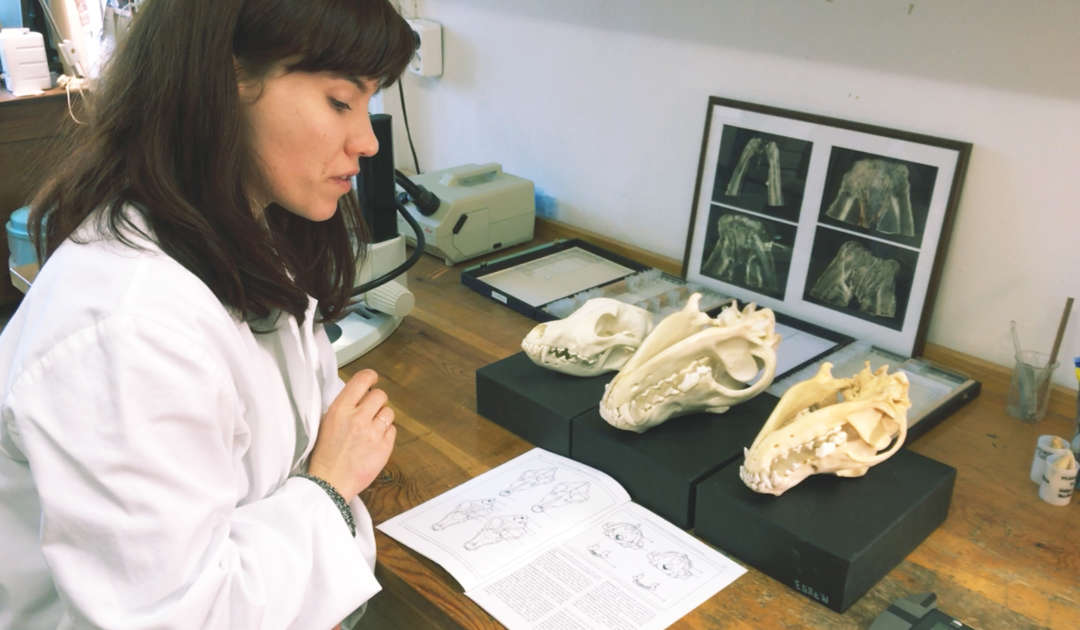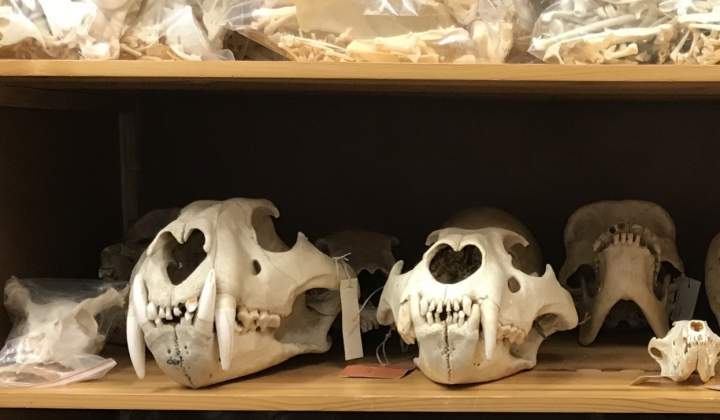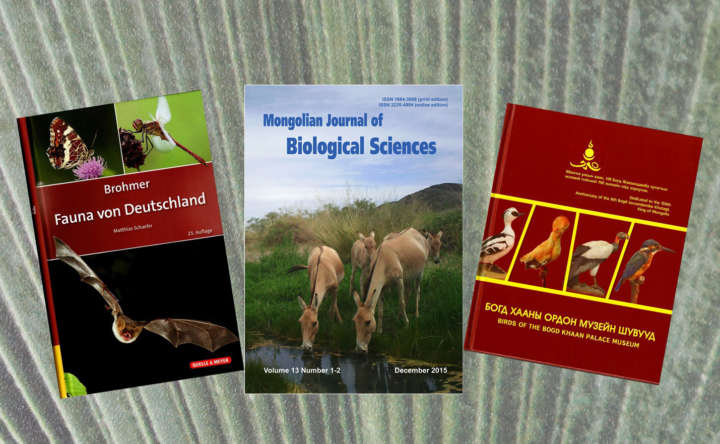
Erforschung intraspezifischer Diversität bei Schimpansen und Bonobos
Die menschliche kulturelle Vielfalt ist enorm. Doch auch Tiere und besonders unsere nächsten Verwandten, die großen Menschenaffen zeigen eine große Vielfalt über Populationen hinweg, z.B. in Sozialstruktur, Demografie oder Verhalten. Zahlreiche Verhaltensweisen unserer nächsten Verwandten, wie z.B. Werkzeuggebrauch weisen eindeutig kulturelle Eigenschaften auf. Mit dem Pan African Programme wurde ein neuer Ansatz in der Erforschung unserer nächsten Verwandten entwickelt, um die Entstehung innerartlicher Vielfalt bei Schimpansen besser wissenschaftlich untersuchen zu können. Dafür wurden an mehreren Dutzend Standorten im afrikanischen Verbreitungsgebiet der Schimpansen über jeweils ein Jahr standardisiert umfangreiche Daten erhoben, u.a. zu Ökologie und Umwelt (mittels Plots und Transekten, sowie Probennahmen), sozialer und demografischer Struktur (mittels Kamerafallen), Genetik, Mikrobiome, Physiologie (nicht-invasiv gesammeltes Probenmaterial) und Verhalten (mittels Kamerafallen). Basierend auf der vorhandenen physischen und digitalen Sammlung werden verschiedenste Analysen zur Dokumentation und evolutionären Entstehung von Populationsdiversität durchgeführt. Aus dem Pan African Programme entstanden auch die Plattform Zambaclound ( www.zambacloud.com ) zur KI- basierten Klassifikation von Arten aus Videos von Kamerafallen, sowie die Citizen Science Plattform Chimp&See ( www.chimpandsee.org ) zur Klassifizierung und Annotierung von Kamerafallenvideos durch Unterstützung von Bürgerwissenschaftler:innen. Das Konzept des Pan African Programme Konzept wurde zur Erforschung der intraspezifischen Diversität von Bonobos ( https://bondiv.org/ ) weiterentwickelt.
IUCN SSC A.P.E.S. Datenbank
Die IUCN SSC A.P.E.S. Datenbank ( https://www.iucngreatapes.org/apes-database ) erfasst und speichert Monitoringdaten über die großen Menschenaffen und Gibbons. Dazu werden die in zahlreichen unabhängigen Feldstudien erhobenen Daten zusammengetragen und standardisiert und damit für unterschiedlichste Analysen zur Verfügung gestellt, z.B. für die Modellierung der räumlich- zeitlichen Verbreitung der verschiedenen Taxa über große Skalen hinweg, zur Untersuchung von Gefährdungsfaktoren oder zur Abschätzung der Wirksamkeit von Schutzmaßnahmen. Das langfristige Ziel ist es die IUCN SSC A.P.E.S. Datenbank an einer oder mehrerer Institutionen im Verbreitungsgebiet der großen Menschenaffen und Gibbons anzubinden.
Behavior Change
In diesem interdisziplinären Projekt werden die Ansätze aus dem Monitoring von Arten, Veterinärmedizin, Ökologie, Anthropologie und Verhaltensökonomie zusammengeführt, um der Frage nach zu gehen, wie möglicherweise riskantes Verhalten durch den Konsum von Wildfleisch (z.B. Übertragung zoonotischer Erreger) verändert werden kann. Das Projekt wird mit verschiedenen Projektpartnern (Universität Daloa und CSRS, Abidjan, Elfenbeinküste, Ecole Inter Etats des Sciences et Médecine Vétérinaires de Dakar, Senegal, Universität Marburg, Helmholtz-Institut für One Health, Greifswald) in der Elfenbeinküste und Liberia in Westafrika durchgeführt.
Projekt „RELynx Sachsen“
In September 2022, the project “RELynx Saxony” started. The Senckenberg Museum for Natural History Görlitz is involved in the coordination of the project as well as the Chair of Forest Zoology of the TU Dresden in the monitoring. The aim is to translocate up to 20 Eurasian lynx of the subspecies Carpathian lynx (Lynx lynx carpathicus) into the forests of Saxony. The animals are wild-caught from Switzerland, Slovakia and Romania, as well as offspring from enclosures away from humans. Orphans that have lost their parents can also be released into the wild. The first lynx will be released in southwest Saxony in the Ore Mountains. Depending on the dispersal behavior of these animals, lynxes may then also be released in the area of Saxon Switzerland. The period for the releases extends from spring 2024 to 2027. The client of the project is the Saxon State Office for Environment, Agriculture and Geology (LfULG). https://www.luchs.sachsen.de/ Contact us: relynx.sachsen@senckenberg.deImplementation concept of the project coordination for the “RELynx Saxony” project
Koncepce provádění koordinace projektu “RELynx Sasko”
DBBW
Senckenberg leads the “Federal documentation and advisory office on the wolf” (”Dokumentations- und Beratungsstelle des Bundes zum Thema Wolf“ DBBW). The DBBW brings the most accurate information on wolf distribution, data and wolf-related events to the public and advice to the authorities. https://www.dbb-wolf.de/Research and teaching in Mongolia
With ecosystems ranging from taiga to desert, Mongolia has a unique natural environment. Despite the vast expanse of the country, serious changes caused by humans, together with natural influences, leave unmistakable traces in the landscape and the flora and fauna of Mongolia. This challenges research and monitoring to protect and utilise Mongolia’s biodiversity. Part of this concerns the diversity of Mongolia’s mammals, which has been jointly explored by Mongolian and German scientists for over 60 years.
Since 2007 there has been a agreement of cooperation between the Faculty of Biology of the National University of Mongolia and the the Museum of Natural History Goerlitz, including research, teaching and collection activities. Based on this agreement, the mammal collection in Görlitz was enriched by over two thousand specimens from Mongolia, including such valuable collections as the world’s most extensive series of skulls of the Przewalski’s horse and the Asiatic wild ass. This collection is regarded as a joint research resource for both countries and is used by Mongolian and German scientists as well as international guest researchers.
In 2016, a Memorandum of Understanding was signed between the Bogd Khaan Palace Museum of the Ministry of Education, Culture and Science of Mongolia and the Senckenberg Museum of Natural History Goerlitz on the “Restoration of the historical bird collection of the Bogd Khaan Palace Museum in Ulaanbaatar” and the training of Mongolian specialists in Ulaanbaatar.
An annual exchange of visiting scientists takes place between the National University of Mongolia and Senckenberg Görlitz. The scientific cooperation has resulted in bachelor’s, master’s and doctoral theses by Mongolian and German candidates on the mammals of Mongolia. These range from the population ecology and genetics of the Asiatic wild ass and the Przewalski’s horse to the feeding ecology of the wolf and the taxonomy, biology and ecology of the house mouse in Mongolia.
Since 2006, joint summer schools with Mongolian students have been held in Mongolia. These small expeditions provided insights into topics such as the scientific principles of sample collecting, recording methods and the preparation of small mammals.


